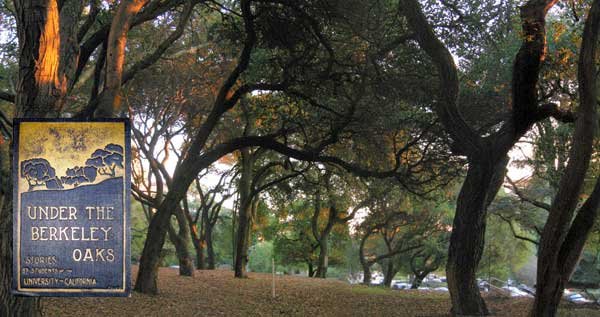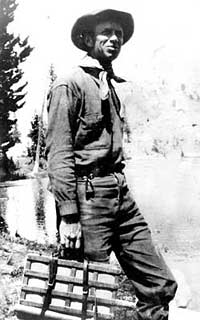 Oak trees, most of them planted by gardeners, have been a symbol of
Berkeley from its early days. They inspired student writers in a 1901 journal, inset, in which Frank Norris made his literary debut.
(Michael Kelly)
Oak trees, most of them planted by gardeners, have been a symbol of
Berkeley from its early days. They inspired student writers in a 1901 journal, inset, in which Frank Norris made his literary debut.
(Michael Kelly)A poet views the oak-grove standoff
Berkeley's Robert Hass muses on conversations about nature that, he regrets, never happened
| 19 March 2009
BERKELEY — The standoff over the now-gone oak trees at Memorial Stadium had much to teach the university community about how to think about nature, said Professor of English Robert Hass. And never has it been so important to think well and complexly about nature, with species vanishing off the earth ever faster.
thesis is that we don't do it very well. By 'we' I mean citizens and poets and scholars in the humanities, and perhaps the university community…"
So said Hass last Thursday, March 12, in his hour-long Faculty Research Lecture at International House. It was a talk that wrapped history, paleobotany, art, poetry, and university tradition into an eloquent, if frequently digressive, argument for deepening our conversations about the environment.
The oak-grove protest, Hass says, played out in the press and in the community as an archetypal battle "between the peace, innocence, antiquity, and natural harmony of the grove and the chainsaws and fences of a university hellbent on financing its athletic programs by delivering ranked teams to the corporate giants that deliver audiences to advertisers at the expense of all the species supported by an oak woodland ecosystem."
But that superficially appealing good vs. evil scenario left out most of the real story of the oaks, Hass said, while causing participants and onlookers on both sides to miss significant opportunities for discussion.
 Berkeley botanist
Willis Jepson catalogued the campus's coast live oaks in 1903. (Bancroft Library)
Berkeley botanist
Willis Jepson catalogued the campus's coast live oaks in 1903. (Bancroft Library)He used his lecture to weave a richer tale, with strands plucked from documents, newspaper articles, an early campus journal, and the writings of scientists. Along the way, Hass invoked the ghosts of many of those who were involved in the creation of Berkeley's brown-shingle Arts and Crafts aesthetic, among them the painter William Keith and the architect Bernard Maybeck. He also brought in the writer and conservationist John Muir and the early university botanist Willis Jepson.
"My subject is thinking about thinking about nature, and my thesis is we don't do it very well," Hass said.
It's essential that the university be a place where its students can learn to do this well, he concluded. That means talking about what "wild" really is and what it's not, for example. And talking about what "nature" is and what it's not, for another.
The oak-grove controversy offered opportunities for both of those discussions, but the conversations did not take place, he said.
It's vital, Hass said, that the university give its students both the kind of urgency that fueled the oak grove sit-in and the patience and complex knowledge they'll need to keep more elements of the natural world from disappearing — if that's still possible.
"We have to act as if we can accomplish it," Hass concluded. "We have to act as if the soul gets to choose."

